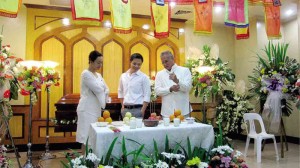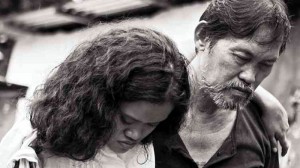Long takes on oft-unheralded section of Cinemalaya
Short films are not as celebrated or as popular among the crowds that gather at Cinemalaya every year. But these filmic exercises in brevity deserve a second look.
The 10 shorts (running time anywhere from eight to 20 minutes) in this year’s indie festival take viewers to places near (Parañaque) and far (Iligan), common (a slum area in North Triangle, Quezon City) and unfamiliar (Navotas fish port).
Most are student films—some deeply personal; others, staunchly political.
Debunking stereotypes
Kissza Mari V. Campano’s “Tutob” was first screened at a fest organized by Institute for Peace and Development in Mindanao. “Tutob” (which refers to the cap worn by Muslim men) was shot in Iligan, Campano’s hometown.
Campano hopes to debunk stereotypes about Moro people through her film. “I wanted to tell a simple story about ordinary people who are often judged harshly.”
Hardest part was shooting a checkpoint scene with real military men. “They suspected that we were subversives disguised as student filmmakers,” Campano related. Eventually, the soldiers agreed to be in the film. “We didn’t pay them a single centavo. We just bought them pizza and, later, a copy of the film.”
Universal story
Jann Eric Tiglao tinkered with the concept of “Onang” for almost two years. “I finally got to shoot it this year.”
According to Tiglao, “Onang” tells a universal story “about wanting to escape one’s situation and chase one’s dreams.”
It features indie favorite Ronnie Lazaro who, Tiglao said, was a joy to work with. “To have a veteran actor in my first post-graduate film was awe-inspiring. He was a pro; he was brilliant. After every take, we found ourselves smiling and applauding.”
“Onang” has been selected for this year’s Rhode Island International Film Festival.
Tribute to granny
Relyn A. Tan also gathered a cast of veterans for her entry, “Para Kay Ama,” a tribute to her grandmother and her Filipino-Chinese heritage.
Che Ramos, Shamaine Buencamino, Dexter Doria and Lito Legaspi lead the cast. “At first, I was intimidated, but [it was] an honor to work with them,” Tan said. “It was a wonderful learning process for me as a director. They were helpful and open to ideas, and they had great chemistry.”
This short was filmed using the long take technique. “The whole film had to be well rehearsed and blocked before the actual shoot. If a line or cue was missed, we repeated the whole thing. It was rewarding in the end,” said Tan.
Undergrad thesis
Philip Adrian Bontuyan and Francis Beltejar’s “Taya” juxtaposes child’s play with grim realities.
The duo’s undergraduate thesis film (at De La Salle University), “Taya” is set in the slums of San Roque, North Triangle, Quezon City—a community under constant threat of demolition.
The filmmakers sought the help of the neighborhood leader and hired kids from there “because they were familiar with, and comfortable in, that setting,” said Bontuyan. Even so, unexpected challenges cropped up. “A drunk disrupted the shoot once. Thankfully, one of the kids knew him.”
Risky locale
Ron Segismundo’s “Bakaw” is similarly set in a “risky” locale—the Navotas fish port at midnight.
Segismundo said his short was inspired by a childhood memory at the port, where the fish his mom had bought were stolen by bakaw or child thief (batang magnanakaw). He found a reformed bakaw, who agreed to act in the film. “He quit because it was dangerous,” said Segismundo.
Casting nonactors was practical, considering budget constraints. “Most of the crew members were my batch mates from De La Salle-College of Saint Benilde where I was a scholar. I graduated last year,” he said.
“Bakaw,” originally made for the Active Vista film fest, hopes to “spark change” by “shaping young viewers’ minds.” This issue of child thieves “deserves the attention of everyone, especially the government,” Segismundo said.
Without a trace
Zig Dulay’s “Missing” tackles yet another pressing problem—the growing number of political activists who have vanished without a trace.
As a college student, Dulay was already interested in human rights issues. “I sympathize with desaparecidos (missing activists) and the relatives they leave behind who fall into sadness and hopelessness,” he said, speaking in Filipino.
The lines between reality and fiction were blurred as Dulay had to film in the midst of real mass protests. “Since they were my friends, my actors gladly showed up.”
Research class
Joaquin Pantaleon, Immanuel Canicosa and Stephan Domingo didn’t have to go far to make their film “Pukpok,” about the Filipino tradition of circumcising young men.”
“We stumbled upon a mangtutuli in Parañaque,” Pantaleon volunteered. “He still practices the old-fashioned method, on his nephews and neighbors.”
He recounted that the film was part of his “research class” at De La Salle. For him, this rite of passage is something that every Filipino male can relate to. “It is very much a part of our culture.”
The Cinemalaya slot is another achievement for “Pukpok,” which was nominated for best short at the Urian awards and won best short film in the New Wave section of last year’s Metro Manila Film Festival.
Promise to uncle
Paolo O’Hara’s “The Houseband’s Wife” is the fulfillment of a promise to his uncle, acclaimed filmmaker Mario O’Hara who passed away last year.
Mario, Paolo recalled, was a “very enthusiastic supporter” of the indie fest. His short film was sparked by another relative, though. “Skype sessions with my sister [abroad] gave me the idea.”
He was compelled to tell this story, he added, “because a lot of Filipino families have OFWs.” His shoot was a family affair, too. “In spite of the meager budget, it was fun because most of my actors were family and friends.”
A woman’s rights
Nica Santiago explained that her short, “Sa Wakas,” which dissects a woman’s right to choose, hits close to home. “It’s important for people to respect others’ decisions,” she said.
She also wanted to show the unique dynamics in a father-daughter relationship. “Fathers can be fun and supportive, too,” Santiago said.
The cast, led by indie vet Raul Morit, was cooperative, Santiago said, though the weather wasn’t. “We rescheduled once because of a storm.”
She was a regular Cinemalaya viewer as a student. “I would watch only because it was required by teachers. I later realized that it was about the lives of ordinary Filipinos.”
Long way from Cebu
Aiess Alonso’s undergraduate thesis film at UP Diliman has gone a long way from Cebu, where it was shot. “Katapusang Labok” was included in the Short Film Corner of the Cannes fest in May.
Alonso said she had always wanted to shoot in her home province, particularly Daanbantayan, and depict the fisherfolk’s struggles to protect the environment and their way of life.
She was moved to action by the words of the late National Artist for Film Lino Brocka: “We must produce films that will not let us rest.” Alonso explained: “My wish is to empower fisherfolk, farmers and laborers, so they can fight for what is rightfully theirs. Only through collective action can we bring about genuine change.”


















